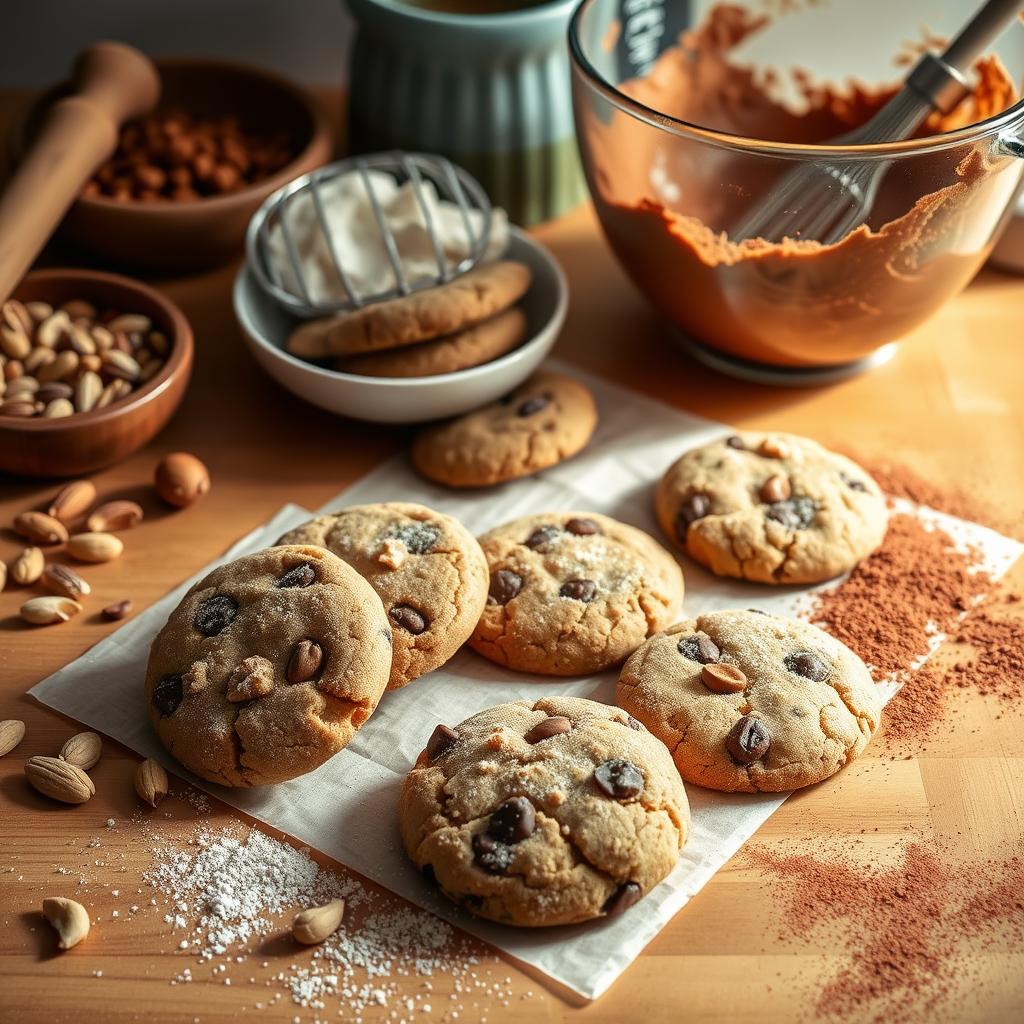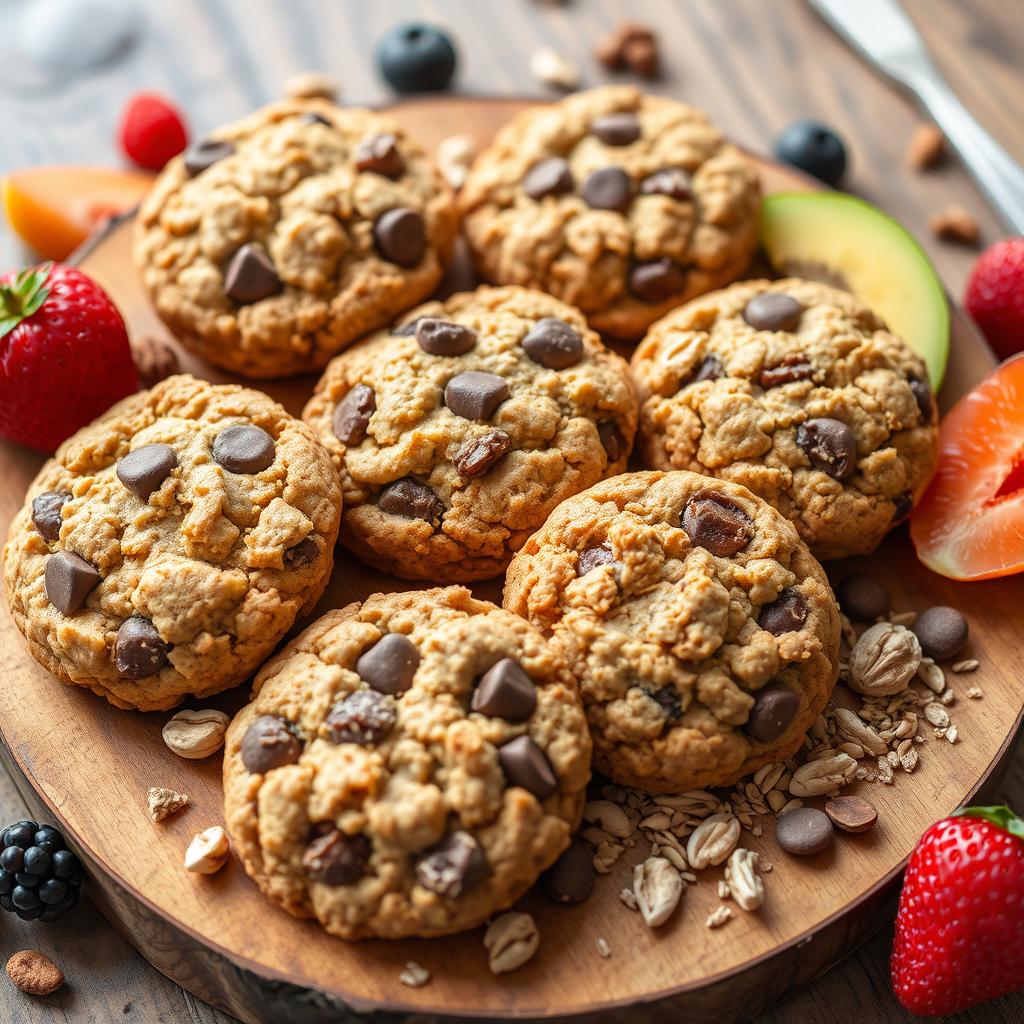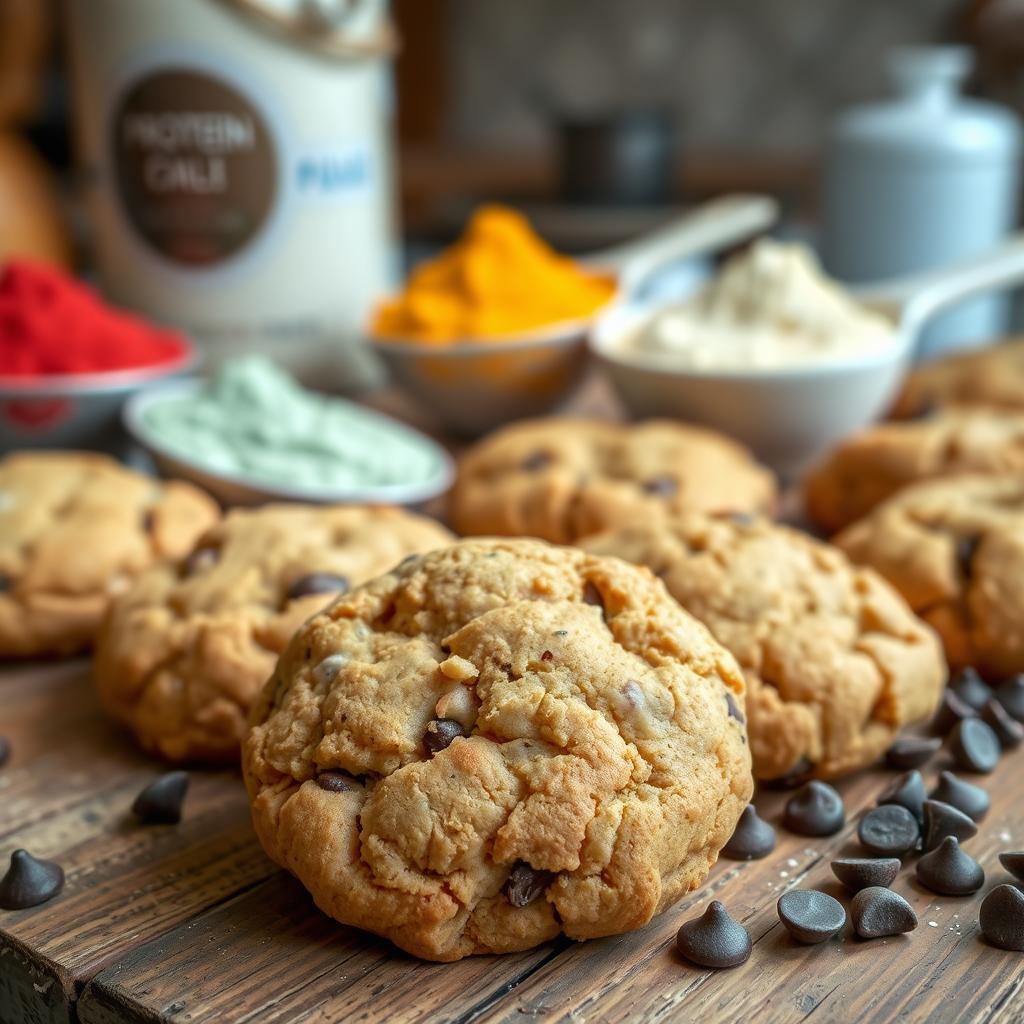Can I use protein powder instead of flour for cookies? If you’re into healthy baking, you might consider using protein powder in cookies. It’s a great way to create treats that are both delicious and nutritious. Let’s explore how to make protein powder cookies that taste great and fuel your body.

Key Takeaways
- Protein powder can be a viable substitute for flour in cookie recipes, offering a healthy twist on a classic treat.
- Understanding the unique properties of protein powder is crucial to achieving the right texture and structure in your cookies.
- Adjusting recipes and using the right binding agents can help you overcome common challenges when baking with protein powder.
- Selecting the right type of protein powder, considering factors like flavor and cost, can significantly impact the outcome of your protein-packed cookies.
- Paying attention to moisture balance and incorporating additional ingredients can help you create delicious, protein-rich cookies with the perfect texture.
Understanding Protein Powder as a Flour Substitute in Baking
More people are turning to gluten-free baking and alternative baking ingredients. They’re finding protein powder to be a great flour substitute. This part looks into how protein powder works in baking, the different types, and their effects on cookie texture.
Types of Protein Powder Suitable for Baking
Not all protein powders are good for baking. Whey, casein, and plant-based options like pea, soy, or hemp are best. Each has its own nutritional benefits and baking properties that change cookie texture and taste.
Chemical Properties of Protein Powder vs Traditional Flour
Protein powders are mostly protein, unlike wheat flour which is mostly carbs. This protein difference changes how cookies bake. They might rise, brown, and hold shape differently. Protein powders also soak up more liquid, so recipes need adjustments.
Role of Protein Powder in Cookie Structure
Protein molecules in protein powders help bind dough or batter. This is especially helpful in gluten-free baking, where texture can be tricky. Protein powders can make cookies lighter and more tender than flour-based ones.

Benefits of Using Protein Powder in Cookie Recipes
Adding protein powder to your cookie recipes can make them healthier and tastier. These nutritious desserts are great for those who love sweets but also care about their health. They help keep muscles strong and support overall health.
Using protein powder in cookies is also good for those on low-carb diets. It lets you make low-carb sweets by swapping regular flour for protein powder. This makes your cookies diet-friendly treats that won’t mess up your health goals.
- Increased protein content to support muscle health and weight management
- Reduced carbohydrate levels for a more nutritionally-balanced treat
- Appeal to fitness enthusiasts and health-conscious individuals
Protein-rich cookies are perfect for athletes and fitness lovers. They offer a tasty and nutritious snack for active people. By adding high-quality protein powder, you make a cookie that’s both delicious and healthy.

“Baking with protein powder is a game-changer, allowing you to indulge in a delicious cookie without compromising your nutritional goals.”
If you want to eat less carbs, more protein, or just healthier sweets, protein powder is a smart choice. It makes baking fun and healthy.
Can I use protein powder instead of flour for cookies?
Many bakers wonder if they can swap protein powder for flour in cookies. The answer is yes, but you need to make some tweaks. This ensures your cookies are just right in texture and taste.
Direct Substitution Guidelines
Start by using protein powder at a 1:1 ratio with flour. So, if a recipe asks for 1 cup of flour, use 1 cup of protein powder. But remember, different protein powders absorb moisture differently. You might need to tweak the ratio for your recipe.
Necessary Recipe Adjustments
- Up the liquid in your recipe, like milk or eggs, since protein powder is drier.
- Adjust baking time and temperature. Protein powder cookies might bake faster.
- Think about adding eggs or nut butter. They help keep the cookies together.
Common Challenges and Solutions
One big problem with protein powder cookies is they can be dense and dry. To fix this, add more liquid, mix protein powder with a bit of flour, or add oats, nuts, or seeds to balance the texture.
| Challenge | Solution |
|---|---|
| Dry, crumbly texture | Increase liquid ingredients, use a blend of protein powder and flour |
| Flat, dense cookies | Add binding agents like eggs or nut butter, adjust baking time and temperature |
| Protein powder aftertaste | Experiment with different protein powder types and flavors, add sweeteners or extracts |
“Baking with protein powder takes some trial and error, but the results can be truly delicious and nutritious.”
Essential Tips for Baking with Protein Powder
Adding protein powder to your cookies can be a big win for health lovers. But, getting the right texture and taste needs some skill. Here are key tips to make your protein cookies soft, chewy, and tasty.
- Adjust the Liquid Ratio: Protein powder soaks up more liquid than regular flour. So, add more milk, plant-based milk, or water. Start with an extra tablespoon for every 1/4 cup of protein powder.
- Embrace Binding Agents: To stop your protein cookies from falling apart, use binders like eggs, ground flax, or chia seeds. They help the dough stick together and keep it in shape.
- Don’t Overmix: Mixing too much can make your cookies tough and dry. Mix the ingredients just until they’re combined. Be careful not to overbeat.
- Experiment with Flour Blends: For the best results, mix protein powder with a bit of gluten-free flour like almond or coconut flour. This helps keep the texture right and prevents the cookies from being too dense.
- Add Moisture-Boosting Ingredients: Use things like applesauce, mashed banana, or Greek yogurt to keep your cookies soft and moist.
By using these tips, you’ll be on your way to making healthy cookie recipes that are both good for you and yummy. Try out different gluten-free baking methods. Find the perfect mix of protein, texture, and taste that you love.
Best Protein Powder Options for Cookie Baking
Choosing the right protein powder is key to baking delicious, guilt-free cookies. Whether you’re looking for healthier alternatives or just want to try something new, knowing the pros and cons of different protein powders is crucial. It helps you get the perfect cookie texture and flavor.
Whey Protein vs. Plant-Based Options
Whey protein is a favorite for cookie baking because it blends well into the dough, creating a smooth texture. But, if you prefer plant-based options, pea, soy, or hemp protein are great alternatives. They cater to different dietary needs and are safe for those with allergies.
Flavor Considerations
The flavor of your protein powder greatly affects your cookies’ taste. Vanilla and chocolate whey powders are popular choices. Plant-based options, on the other hand, come in various flavors, including unflavored. This lets you customize your cookies to your liking.
Price and Availability Factors
| Protein Powder Type | Average Price Range (per pound) | Availability |
|---|---|---|
| Whey Protein | $8 – $15 | Widely available in most grocery and health food stores |
| Plant-Based Protein (Pea, Soy, Hemp) | $12 – $20 | Readily available in health food stores and online |
When picking a protein powder for baking, think about your budget and where you can find it. Researching and comparing different options helps you find the best one for you.
Moisture Balance and Texture Considerations
Using flour substitute cookies like protein powder in baking is tricky. You need to get the moisture and texture right. Protein powder is different from regular flour, so it changes how your cookies turn out.
Protein powders soak up more liquid than flour. This can make your cookies dry and crumbly. To fix this, you must adjust the liquid in your healthy cookie recipes carefully.
- First, cut down the flour by 25-30% and add the same amount of protein powder.
- Then, add 2-3 tablespoons more of wet ingredients like eggs, milk, or oil for each cup of protein powder.
- Keep adding a little extra liquid until the dough feels just right – not too dry or too wet.
The type of protein powder you pick also matters. Whey protein makes cookies soft and cake-like. On the other hand, plant-based proteins like pea or hemp make them denser and chewier.
| Protein Powder Type | Cookie Texture |
|---|---|
| Whey Protein | Tender, cake-like |
| Plant-Based (Pea, Hemp) | Denser, chewier |
Try out different protein powders and liquid amounts to get the perfect flour substitute cookies. This way, you can make the healthy cookie recipes you want.
Additional Ingredients Needed When Using Protein Powder
Adding protein powder to your cookie recipes might require extra ingredients. These help achieve the right texture, taste, and nutrition. Together, they make your protein cookies tasty and healthy.
Binding Agents
Protein powder can make cookies crumbly. Eggs, nut butters, or ground flaxseeds can fix this. They mix the dough well, making the cookies firm.
Sweeteners and Flavorings
Protein powder can taste chalky. Sweeteners like honey, maple syrup, or vanilla extract can help. They make your cookies sweeter and more flavorful.
Texture Enhancers
Adding almond flour or coconut flour makes cookies soft and chewy. These ingredients also make your dessert healthier.
Choosing the right extra ingredients makes protein cookies delicious and nutritious. They offer a healthy treat option.
Common Mistakes to Avoid When Baking Protein Cookies
Baking protein-packed cookies is a fun and healthy way to enjoy sweets. But, it’s key to avoid common mistakes. When you add protein powder to your cookies, remember these tips for success.
One big mistake is overmixing the dough. Unlike regular cookies, mixing too much can make protein cookies tough. Mix just until everything is combined, and don’t overwork the dough.
Another mistake is baking them too long. Protein cookies dry out fast, so watch them closely. Set your timer a bit early and check them often to avoid dryness.
- Avoid over-mixing the dough to prevent tough, dense cookies.
- Keep a close eye on the cookies in the oven to prevent overbaking and dryness.
- Adjust ingredient ratios to maintain the proper moisture balance.
- Incorporate binding agents to help hold the cookies together.
- Experiment with different types of protein powder to find the best fit for your recipe.
Getting the right mix of ingredients is also key. Protein powder absorbs moisture, so you might need to adjust other wet ingredients. This helps keep the cookies moist and right.
Don’t forget to add binding agents like nut butters or xanthan gum. They help the cookies stay together and prevent crumbling.
By avoiding these mistakes and trying different protein powders, you can make tasty, healthy cookies. They’ll satisfy your sweet tooth without losing texture or taste.
Nutritional Benefits of Protein Powder Cookies
Using protein powder instead of flour in cookies brings many health benefits. These low-carb sweets are not only tasty but also packed with nutrients. They are perfect for those who want to enjoy treats without feeling guilty.
Macronutrient Profile
Protein powder cookies have a better mix of nutrients than regular cookies. They have a lot of protein, which helps build and repair muscles. They also have fewer carbs, making them good for low-carb diets.
Caloric Comparison
Protein powder cookies often have fewer calories than regular cookies. This is because they use protein instead of flour, sugar, and butter. This makes them a better choice for those watching their calorie intake.
Dietary Considerations
Protein powder cookies fit many different diets. Whether you’re on a low-carb, gluten-free, or vegan diet, there’s a protein powder for you. This means you can enjoy tasty, healthy cookies that fit your dietary needs.

